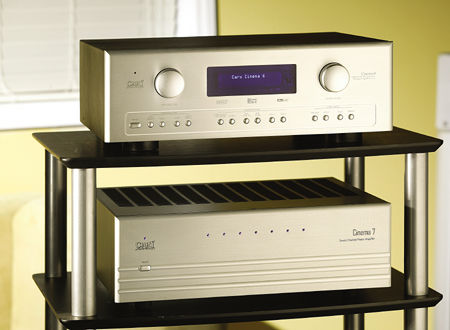Cary Audio Cinema 6 Pre/Pro and Cinema 7 Amplifier
Home theater in 2004 is like America in the 1950s, with a middle class that has steadily been building momentum and now finds itself in the midst of a major breakout. The same philosophy of the good life at a better price that spawned a culture of suburbs and credit-card debt in the '50s is spawning an unprecedented emergence of high-end home theater components at mid-level prices in the '00s.

Ironically, these two pushes toward the middle have come from opposite directions. America's middle-class explosion primarily consisted of those in the lower ranks who were able to improve their situation and press upward, while home theater's new middle class is bulging with names from the upper ranks who have chosen to make themselves more available and stop missing out on all the fun (and all the dollars). Call it democracy, call it capitalism, call it whatever you want, but it's happening—and interesting opportunities will follow.
Meet in the Middle
Naturally, the best scenario for the buyer is when these high-end components take as few hits as possible on their journey to the middle price points. Cary Audio's Cinema 6 pre/pro ($2,500) and Cinema 7 amplifier ($2,200) are great examples of how to survive the trip intact. Obviously, with the mid-priced models, manufacturers can't deliver the same level of cost-no-object internal components at every turn that they can with the cost-no-object models; however, when the design principles, the reliability, and (most importantly) the drive for performance and fidelity remain intact, some very good things can result from equipment that doesn't cost nearly as much as it could.
Keep context in mind. Just because the Cinema 6 and Cinema 7 don't mirror their higher-ticket brethren part for part doesn't mean that there isn't plenty that's still the same; also, the component substitutions that do exist aren't exactly coming from the bargain bin. All of the channels on the Cinema 6 get 24-bit/192-kilohertz audio digital-to-analog converters, making it one of the few pre/pros that can process 192 kHz. The Cinema 6 can also upsample incoming digital audio signals to twice their original frequency (44.1 kHz to 88.2 kHz or 96 kHz to 192 kHz). All of the chipsets are in place for the latest processing modes. Both the Cinema 6 and Cinema 7 are solid on the internal-components front, and I formed a strong sense of their value even before I turned them on.

Connections are well covered on the Cinema 6 and Cinema 7. About the only obvious omission from Cary's bigger-ticket offerings are balanced inputs and outputs, which aren't common or entirely necessary on models at this price. Digital and analog audio connections are ample on the Cinema 6, including two 7.1-channel inputs, both of which you can set for full bypass (as you can with the stereo inputs). The component video connections are high-bandwidth, and a second zone gets stereo analog and composite/S-video outputs. The Cinema 7 has gold-plated RCA inputs, real five-way binding posts, and remote triggers.
Setup Made Simple
Quick, easy setup is hardly the A/V receiver's domain anymore. Pre/pros have made giant strides here, and the Cinema 6 is a prime example. In fact, short of automatic calibration systems, I haven't come across an easier setup on any piece, receiver or pre/pro. Make your connections, use the intuitive onscreen menu and well-designed remote (and a good manual, if you need it) to run through the basic settings, and you're done. As you should expect, there isn't the level of tweaking available that you'll find on some of the higher-end pre/pros, but there's more than enough for most users. I set up the Cinema 6 and Cinema 7 with an Energy Veritas V2.4 speaker system and Marantz DV8300 universal disc player, and I went from unboxing to fine-tuning in under a half-hour.
Before I formally introduced the Cinema 6 and Cinema 7 to my multichannel system at home, I set up the former with the Aragon Palladium monoblocks and the Krell KAV-500 amp. They've been my primary power anchors for some time, and I know their sound well. This gave the Cinema 6 ample opportunity to prove itself in the first (and, to me, the most important) pre/pro test: resistance to editorializing. I'm much more tolerant of coloration (or sonic character, if you're the glass-half-full type) in amps and speakers. It's hard enough to find amps and speakers that like each other; I don't want to worry about source units and pre/pros adding their two cents. As such, the Cinema 6 immediately ingratiated itself to me with a sound that was significantly more transparent than I expected from a pre/pro at this price. I've been lucky enough to have the best pre/pros in the world come through this system; while the Cinema 6 wasn't the open window that some of them have been, it's not as far off as you might expect. That's truly saying something when you consider that it averages out at some 25 percent of the cost of the top-shelfers.
With neutrality in the Cinema 6 confirmed, it was time to let the Cinema 7 in on the fun. It quickly proved to be impressively free from coloration, as well—highly significant for a solid-state, multichannel amplifier, especially a less-expensive one. Naturally, I can only make a comprehensive opinion of an electronics combination after weeks or months of listening, but I like to see a pairing that makes a good first impression, too—which this Cary combo certainly does.























































